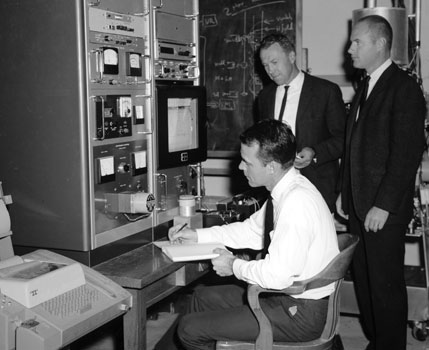|
|
||||||||||
 |
|
|
|
|||||||
|
|
||||||||||
|
|
|
|
|
|
|
|
|
|||
|
|
|
|
|
|
|
|
|
|
|
|

Allan Cox
Cox' mentor at the University of California, Berkeley as Professor John Verhoogen, a geophysicist nearly alone in his belief in the 1912 hypothesis of Alfred Wegener, which proposed that the continents were not fixed in their present positions on the Earth's surface, but over geologic time had drifted widely - the continental drift theory. Cox was intrigued by Verhoogen's lectures on continental drift, a theory not examined in any of his other classes.
Allan Cox (seated) with Richard Doell (left) and Brent Dalyrmple (right) at a gas mass spectrometer. This photo was taken sometime in the early 1960s. Image courtesy of Stanford School of Earth Sciences. |
Early in his career, experiments to determine the timing of reversals in the Earth's magnetic field, conducted at the U.S. Geological Survey in Menlo Park with Richard Doell and Brent Dalyrmple, led to unanticipated findings. The group demonstrated that reversals of the Earth’s magnetic field had occurred, and they were able to use radioactive isotopes to date the reversals. The result was a time scale based on variations in the Earth’s magnetic field, which later proved to be the “Rosetta Stone” for deciphering the pattern of magnetic anomalies on the sea floor. The ocean crust was demonstrated to be moving, with parts of the crust on the two sides of a ridge drifting apart: solid evidence that great areas of the Earth's crust are in motion, one of the principal kinds of evidence that paved the way for the theory of plate tectonics.
After Cox came to Stanford in 1967, his work in paleomagnetism attracted many students to the field. Together they attempted to explain the curious pattern in the geology of the rocks that make up the west coast of North America, where elongated areas of rock of very different kinds, structures and ages exist side by side, as if they had come from a great distance and been successively jammed against the continent. Using computer graphics, Cox and his students made animated diagrams to illustrate these movements. The magnetic properties of rocks provided not only a key to the initial concept of plate tectonics, but also a wealth of data on the large-scale movement of crustal plates in the Earth's past.
After twelve years on the faculty, Allan became Dean of the School of Earth Sciences in 1979. He served in this position until his unexpected death in 1987.
